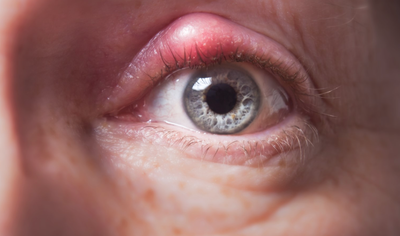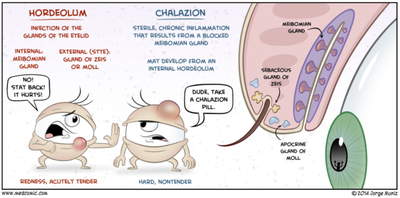What is a stye?
The stye is a bump that is formed on the edge of the eyelid of the eye, right where the eyelashes are located. This happens when a sebaceous gland inflames, which becomes a kind of reddish, grain-like ball that is very tender to the touch.
Styes or bumps in the eye are few that escape, in fact, it is believed that every person will suffer from a stye at least once in their life. The truth is that this condition is so annoying and painful, that most of the people who suffer from it anxiously seek a solution to cure stye quickly.
Types of stye
There are two types of standards:
Outer stye
El external stye It is most common to appear there on the edge of the eyelid. It has a grain-like shape and spontaneously empties after about 4 days after it appears.
The main cause of external stye is infection of Zeiss sebaceous gland or Moll sweat gland.
Internal stye
El internal fastener it is located far from the edge of the eyelid. It is reddish like a grain which begins to form and takes longer to drain. If you do not do this within the first 10 days, you should see a doctor.
The main cause of internal stye is infection of one or more meibomian glands.
stye
Causes of a stye
El stye occurs when a blockage in one or more sebaceous glands in the eyelid. This facilitates the bacteria to multiply, the gland to inflame and form a kind of infected grain. In fact, its formation is very similar to that of acne thorns which, remember, occurs when a pore in the skin becomes clogged with excess fat and bacteria.
A person can have more than one stye in the same eye at a time. Among the most common bacteria that cause this inflammation highlight staphylococcus. This condition can appear in a few days, which is why it always comes on unexpectedly. Sometimes the sebaceous gland spontaneously empties and the stye heals on its own before it gets bigger. Others, however, the gland can become blocked to such an extent that it impairs vision, this condition is known as chalazion.
Blepharitis These are the inflammation, irritation, and itching of the eyelids with no specific cause, although it is believed to occur due to the build-up of bacteria. People with blepharitis are more likely to have styes.
Symptoms of a stye
The main symptoms to identify a stye are:
A lump in the eye forms.It looks red and may or may not have a white spot in the center, usually pus.
Sensation of having a foreign object in the eye
Irritation y sensation of heat on the eyelid
Increased secretion of tears.
Sensitivity to light.
Pain and tenderness on the eyelid
Discomfort when blinking.
Watery eyes.
Sensation of irritation and burning.
Swelling of the eyelids.
Depending on the type of stye, the lump can stay in the eye for at least 10 days after it forms.
How to cure a stye
When a stye does appear, it is important to treat it quickly. The stye can usually last around 10 days in the eye. During this time, we recommend that you use warm compresses on the eye to relieve symptoms and the use of lubricant and antibiotic drops.
However, we must take into account a series of taking care to prevent this condition from getting worse:
Do not touch, squeeze, click, or rub the stye with your hands or any other object.
I will always wash my hands with antibacterial soap to avoid drawing more bacteria into my eyes.
Do not wear makeup.
Avoid wearing contact lenses.
Do not self-medicate.
In the event that the stye does not disappear within a week or ten days, we may be in the presence of a cystic stye. In this case, the most common treatment is surgical removal.
Why Consult?
Chalazion most often occurs in an inflammatory fashion, with an array of red, swollen and tender eyelids. At this stage, the treatment is medical and requires a prescription for anti-inflammatory ointment prescribed by your ophthalmologist. The evolution is most often towards the disappearance of the inflammation and the collapse of the cyst, over a variable period of 6 days to 6 weeks, unlike the stye which has a brief evolution, generally less than 'one week.
In some cases, the chalazion becomes chronic and the eyelid cyst is no longer painful, but takes the appearance of a persistent or even recurrent lump in the same place, requiring surgery. In rare cases, the chalazion can become infected and give a picture of eyelid cellulitis, which requires systemic antibiotic treatment.
To behave
In the inflammatory phase (swollen and sensitive red eyelid), seek urgent advice to start treatment, which reduces the duration of the inflammation.
In the infected phase, consult to start an antibiotic treatment which helps to limit the course and progression.
In the encysted phase, consult to assess the value of a surgical incision under local anesthesia.
If you have these symptoms, it is possible to go urgently to the SOS Oeil, where walk-in consultations are offered 7 days a week from 8 a.m. to 10 p.m. It is also possible to make an appointment at the Paris 17 Ophthalmological Center.
The place of the surgical incision
A chalazion can encyst. A ball, mobile and painless, sometimes unsightly, the size of which is stable over time, then settles in the eyelid. This situation most often justifies an incision if one wishes to get rid of the chalazion. This is a procedure that is performed under local anesthesia. At the ophthalmological center, a consultation is systematic before any incision for the following reasons:
1 / Expose the benefits and risks, first and foremost that of recidivism (around 10%).
2 / Ensure the correct indication:
- Treatment well conducted by massages and eyelid treatments for at least 15 days
- Non-inflammatory eyelid (= white and painless) to promote healing, prevent pain and recurrence.

